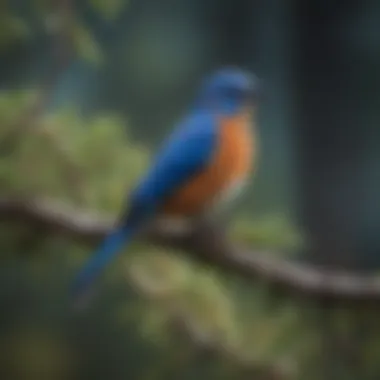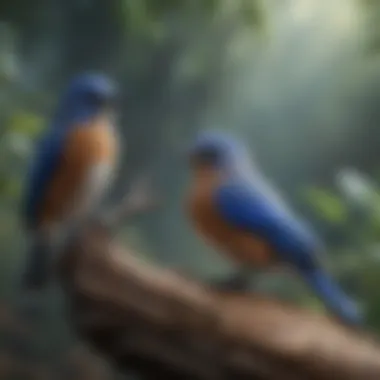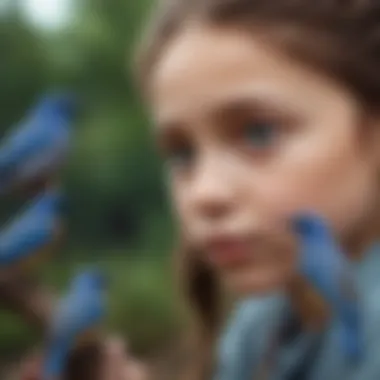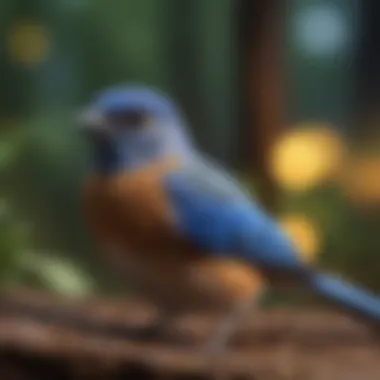Creative Naming Ideas for Blue Birds


Nature Topic Overview
Naming a blue bird goes beyond simply assigning a title. It provides an opportunity to explore the avian world and connect with nature in a meaningful way. Names can reflect various attributes like color, behavior, or habitat of birds. Additionally, understanding the significance of these names enhances our appreciation for wildlife as a whole. Names often carry cultural weight or historical significance, linking generations to nature. Throughout this article, we will discover creative ideas and considerations that will help in selecting insightful names for blue birds.
Fun Facts and Trivia
- Blue birds are often associated with happiness and good fortune in different cultures.
- The blue color in birds comes from the structure of feathers rather than pigments.
- Interestingly, blue birds can be found on every continent except Antarctica.
Interactive Idea:
Try creating a scrapbook with facts about your favorite blue birds. Use bright colors and illustrations to make it engaging.
Wildlife Explorations
Blue birds are a fascinating group, with various species showcasing unique traits. For example, the Eastern Bluebird is known for its cheerful song and vibrant plumage. In contrast, the Indigo Bunting boasts striking blue feathers but may appear brownish during fall. Exploring these differences highlights not only diversity but also the importance of habitat preservation.
- Eastern Bluebird:
- Indigo Bunting:
- Habitat: Open woodlands and fields
- Diet: Insects and fruits
- Habitat: Brushy areas
- Diet: Seeds and insects
Fun Fact: Many blue birds engage in cooperative breeding, where individuals help raise young that are not their own.
Environmental Awareness
Conserving blue birds and their habitats is crucial as environmental changes threaten their survival. You can help protect these species by fostering a love and appreciation for nature. Engaging in community cleanups, building birdhouses, and planting native plants are all effective ways to contribute.
"Every small action has the potential to create significant impact on wildlife conservation."
DIY Nature Activities
Encouraging children to connect with nature can be highly beneficial. Here are some enjoyable activities related to naming blue birds:
- Bird Watching Journal:
Keep a log of different blue birds spotted in your area. Note their behaviors and what they are doing. - Nature-Inspired Crafts:
Use recyclable materials to create bird feeders or decorations. - Outdoor Explorations:
Plan a local field trip to a bird sanctuary or park to observe blue birds in their natural habitat.
By engaging in these activities, young learners can apply their newfound knowledge while enjoying nature.
In summary, naming blue birds opens an exciting pathway to discover their unique characteristics and the roles they play in ecosystems. Through understanding, creativity, and balanced approaches towards conservation, we can inspire future generations to cherish these vibrant creatures.
Preamble to Blue Birds
The realm of ornithology, though it may seem niche to some, harbors countless engaging aspects that enrich human understanding of nature. Naming a blue bird, for instance, extends beyond mere label; it encapsulates the character and traits attributable to these splendid creatures. This article delves into the intricate art and science of naming these birds, guiding readers through creative thought processes and cultural significance. The endeavor to name a blue bird can foster connections between children and the biodiverse world, promoting awareness about wildlife.
The importance of understanding blue birds cannot be understated. Knowledge of their species, habitats, and behaviors may further inform naming practices. By exploring the cultural perspectives on names, readers gain insight into how different societies view these animals. Such explorations pave the way for richer naming conventions which reflect both individual creativity and cultural backgrounds.
This section lays the groundwork for subsequent segments that highlight traits of blue birds, practical naming considerations, and sources of inspiration. Ultimately, readers encouraged to think deeply about name selection will find themselves with a trove of resources and concepts that rejuvenate their connection to nature.
Understanding Blue Birds
The diversity of blue birds encompasses various species that showcase both commonalities and unique characteristics. For instance, the Eastern Bluebird is a charming sight in backyards, while the Blue Jay is known for its intelligence and distinctive cry. Some may be surprised to learn that not all blue birds are actually blue. The appearance of their feathers results from light scattering, giving them that vivid color.
When naming blue birds, it becomes essential to grasp the essence of the species—its behavior, habitat preferences, and more. For example, understanding that bluebirds thrive in open fields dominated by trees can lead to inspiration derived from their environment. Little observations like this will inform the naming process, forging deeper connections between name and nature.
The Beauty of Blue Feathers


The aesthetic appeal of blue feathers captivates enthusiasts and casual observers alike. Shades can vary significantly, ranging from pale sky blue to rich cobalt. This vibrant color serves as a major draw for birdwatchers and contributes to a bird's identification.
Beauty in nature also tends to provoke emotional responses. A person might feel particularly attached to the name given to a bird that graced their childhood neighborhood. Such personal anecdotes highlight the subjective nature of beauty and how it becomes entwined with naming.
"Colors in nature are a spectrum that can evoke memories and emotions, making them valuable in naming endeavors."
In summary, the introduction to blue birds serves not merely as a lead-in but as a stepping stone to deeper knowledge and understanding. The next sections will explore further characteristics and perspectives, enriching the narrative of blue birds and instilling creativity in naming.
Cultural Perspectives on Naming
Naming a blue bird extends beyond mere identification; it embodies the intersections of culture, tradition, and personal significance. Understanding the cultural perspectives on naming enriches our appreciation for these vibrant creatures. It highlights how diverse societies assign meaning to names based on their beliefs, geography, and history. By exploring these cultural nuances, we can better appreciate the names we choose for our feathered friends.
Names in Different Cultures
Different cultures have distinct methods of naming birds, influenced by local customs and languages. For instance, in some Indigenous cultures of North America, birds are often named after their behaviors or sounds. Names might literally mean "chirper" or "flyer," which reflect the characteristics that stand out.
In other places, blue birds hold special meanings. In Japan, the bluebird symbolizes happiness and good fortune, which can be reflected in names. Similarly, in parts of Europe, the bluebird is seen as a messenger of love and joy, leading to names that signify these traits. Here are a few examples of what blue birds are called in various cultures:
- American Indian: Nighthawk emphasizes its majestic flight.
- Japanese: Aozora means "blue sky," linking the bird to its natural habitat.
- European: Lutino often describes color and charm in Italian dialects.
These examples show how culture shapes our connections with blue birds through naming.
The Meaning Behind Names
Each name carries a story. When naming a blue bird, understanding the meaning behind different suggestions can connect us more deeply with the animal. In many cultures, names derived from nature often reflect admiration for the environment. For instance, in Celtic culture, birds are associated with various gods and spirits. A name like Brenna meaning "little raven" showcases this connection.
Furthermore, names can evoke feelings and emotions. Names like Sky or Azure evoke images of vast skies. This illustrates how naming can reflect aesthetic and emotional values. It can even be an educational moment for children to learn about the symbolic meanings embedded in the names.
"A name is more than a label. It is a bridge to culture and understanding."
Characteristics of Blue Birds
Understanding the characteristics of blue birds is fundamental in the naming process. Each species exhibits unique traits that not only define their identity but also influence potential names. Winners of avian beauty, blue birds are often celebrated for their vibrant colors and engaging behaviors. Recognizing these aspects contributes to a more informed and meaningful naming experience.
Habitat and Behavior
Blue birds inhabit a variety of environments ranging from forests to open fields. Their preferred habitats are often dictated by the availability of food and nesting resources. In the wild, you can find species like the Eastern Bluebird, primarily in open country with scattered trees. This gives you an idea of their affinity for certain landscapes.
Observing their behavior can be quite fascinating. For example, blue birds usually display a charming courtship ritual, where males perform aerial displays to attract females. This behavior can inspire names related to agility or grace. Additionally, their social nature makes them excellent indicators of a healthy ecosystem.
Some common behaviors to note include:
- Foraging habits: Blue birds often hunt for insects or berries, showcasing their adaptability.
- Nesting patterns: Different species prefer varied nesting sites, from natural cavities to man-made birdhouses.
- Communication: They use a range of calls, often making their presence known through distinct songs.
"The environment and behavior of blue birds provide essential context that can greatly influence naming decisions."
Diet and Feeding Habits
The diet of blue birds plays a crucial role in their development and survival. Most species feed on insects, fruits, and seeds. Their feeding habits not only reflect their role in the ecosystem but also offer insight into their personalities. For example, the Western Bluebird frequents open fields to catch insects mid-flight, while the Blue Jay is known for its intelligence in collecting and storing food.
Here are key considerations regarding their diet:
- Insectivorous: Many blue birds actively hunt insects, which is vital for their nutrition, especially during breeding seasons.
- Fruit Lovers: They are also known to enjoy berries, which makes their presence especially visible in fruit-laden trees.
- Seasonal Variations: Their diet can change with seasons, influencing migration patterns and localized naming themes.


Understanding the diet and feeding habits of blue birds adds depth to the naming journey. You gain not only a name that suits the bird’s physical appearance but also one that resonates with its lifestyle and habits. This approach allows for a more thoughtful and personal naming process.
Sources of Inspiration for Naming
Naming a blue bird can be a delightful yet complex task. This section illustrates the various sources that can inspire creative and meaningful names. Understanding these sources allows us to connect more deeply with the natural world. Each name we create holds significance, often reflecting the bird's attributes or characteristics. Recognizing the origins of names adds dimension to our appreciation of wildlife, enhancing our experiences when observing these creatures.
Nature and Environment
Nature serves as a potent muse. The environment in which blue birds thrive offers ample inspiration. Their habitat influences potential names. For example, if a blue jay resides near a lake, one might consider names such as "Aqua" or "Splash." Variations in habitat also influence dietary habits, behaviors, and social interactions.
Inspiration can stem from the colors and textures found in their environment. A bluebird perched amid vibrant flowers can evoke names focusing on floral references, like "Petal" or "Blossom." The distinctive blue hues of the bird itself can lead to names that celebrate this unique coloration. Choices like "Sky" or "Ocean" convey the beauty of their appearance while reflecting their connection to nature.
Furthermore, observing the behavior of blue birds in their natural habitat can lead to imaginative naming ideas. For example, a swift and agile bird might be aptly named "Flash" for its speed. Alternatively, a bird known for its melodic singing could inspire names like "Melody" or "Chorus."
Literature and Mythology
Literature and mythology provide rich sources for inspiration when naming blue birds. Many cultures possess tales and folklore where blue birds figure prominently. Each story offers unique characteristics that can inspire names. For instance, in various mythologies, blue birds often symbolize hope, freedom, or wisdom. A name like "Hope" or "Elysium" could embody these themes.
Additionally, well-known literary works often reference birds. For instance, one might draw inspiration from classic literature where blue birds symbolize the quest for happiness. Names like "Happiness" or shorter forms such as "Joy" reflect these themes succinctly while expressing deeper meanings.
Another approach is to utilize notable characters from literature featuring a blue bird. Characters could bring forth names that resonate with personality traits associated with them. Think of names like "Huck" inspired by Huckleberry Finn, or names such as "Gulliver" from Gulliver's Travels, imbuing the naming process with narrative depth.
In summary, the combination of the natural environment and rich literary references provides abundant inspiration for naming blue birds. Both nature and literature allow us to enhance our emotional connection with these animals while ensuring that each name carries significance and depth.
Practical Considerations in Naming
Naming a blue bird is an exercise that transcends simple identification. It's a process that involves careful thought about various factors. A well-chosen name not only captures the essence of the bird but also resonates with the person naming it. This section highlights two key aspects of practical considerations: simplicity and memorability, and gender-specific names. These elements are crucial in ensuring the name serves its purpose effectively.
Simplicity and Memorability
Simplicity is vital when it comes to naming a blue bird. A name that is easy to pronounce and remember makes it more likely that it will be used consistently. Complex names can lead to confusion, especially for children. For instance, names like "Sky" or "Cobalt" are both simple and resonate with the color of the bird.
It's essential to keep in mind the target audience as well. Children aged five to twelve often respond better to names that are short and catchy. A name should evoke a mental image but not overwhelm with length or complexity. Good examples can include single-word names or those that are not too long, making them easier to say.
Additionally, memorable names tend to stick in one's mind. When someone can easily recall a name, it promotes connection and affection towards that bird. This connection can enrich the experience of owning or observing the bird, fostering a deeper appreciation for wildlife.
Gender-Specific Names
Choosing a gender-specific name may add another layer of personalization. While not everyone feels the need to assign gendered names, it can enhance the relationship between a person and their bird. Male and female blue birds often exhibit distinct behavioral traits. For example, male bluebirds are known for their vibrant coloring and courtship behavior, while females may appear more subdued.
Selecting a name that aligns with the bird's gender can reflect these characteristics more accurately.
- For male blue birds, names like "Azure" or "Indigo" might be fitting, emphasizing their striking appearance.
- Female blue birds might be better suited with names like "Cielo" or "Marina," reflecting a softer aspect of their character.
Ultimately, the decision of whether to use gender-specific names will depend on personal preference. What matters most is that the name feels right to the owner and captures the bird’s unique personality.
In naming a blue bird, consider simplicity for memorability and reflect on gender to enhance connection. Choosing thoughtfully enriches the bird's presence in one’s life.
Popular Names for Blue Birds
Naming blue birds is not just a trivial activity; it is a reflection of the connections we foster with these enchanting creatures. Popular names often convey shared cultural meanings and personal stories, enriching our understanding of nature and our relationship with it. Choosing the right name can be both a thoughtful and expressive process, helping to create a bridge between the natural world and our imaginative lives. It can also serve as a way to connect children with nature, allowing them to appreciate the beauty and uniqueness of blue birds. In this section, we will explore both historical names and contemporary trends to shed light on the significance and evolution of popular names for blue birds.
Historical Names


Historical names give us insights into how society has viewed blue birds across the ages. Many cultures have rich traditions associated with these birds, often rooted in mythology or folklore. For instance, the Indigo Bunting was named in the 18th century, and this name highlights not only the color blue but also the distinctiveness of the bird. Similarly, names like the Eastern Bluebird echo the habitats and regions they are found in, giving us clues about their natural preferences.
Common historical names often possess a lyrical quality. The names often arise from poems or stories, becoming timeless. For example, the name "Sky Lark" was commonly used to describe birds that connected with the blue sky. This tradition helps preserve cultural heritage while educating younger generations. Understanding these historical names allows children to appreciate the birds' roles in stories, encouraging exploration and curiosity.
Here are some historically significant names for blue birds:
- Indigo Bunting
- Eastern Bluebird
- Blue Jay
Modern Trends
As time evolves, so do naming conventions. Modern trends often reflect a shift toward playful and creative expressions. In recent years, names like "Bluie" or "Sky" have become popular among children. These names are easy to remember and resonate with the visual attributes of blue birds. The trend also emphasizes a growing interest in individuality, where names may reflect personal connections or feelings rather than historical significance.
Social media platforms like Reddit and Facebook have played a part in modern naming trends. Parents and children share their unique naming ideas, creating a community of inspiration. For example, parents might find inspiration in trending names like "Ocean" or "Cerulean" that elegantly encapsulate the birds’ essence.
Modern naming trends are often influenced by the following:
- Popular culture references (games, movies)
- Environmental movements
- Unique and personal stories
In summary, popular names for blue birds are a tapestry woven with historical context and modern creativity. Through understanding these names, we can teach children the significance of naming as both an art form and a reflection of our cultural values.
Encouraging Creativity in Children
Encouraging creativity in children is an essential part of their development. In the context of naming blue birds, creativity can ignite a child’s imagination and foster a strong connection to nature. The process of naming can be a joyous experience. It involves observation, reflection, and even storytelling, all of which are beneficial for cognitive development. When children engage with the task of naming, they learn to appreciate the uniqueness of each creature. This exercise not only boosts their creative faculties but also enhances their vocabulary and communication skills.
Beyond mere fun, naming activities provide a platform for learning. Children begin to understand important concepts such as identity and classification in the natural world. They might consider color, behavior, or environment when choosing names, which can lead to broader discussions on biology and ecology.
Activities for Kids
Here are some engaging activities that can spark creativity when naming blue birds:
- Birdwatching Journals: Encourage kids to observe blue birds in their natural habitat. Have them document their observations in a journal. They can describe the bird’s appearance and behavior. This can inspire unique names based on their observations.
- Art Projects: Provide art supplies and ask children to create their interpretation of blue birds. Once completed, they can brainstorm names that reflect their artwork. This unifies art and naming in a creative way.
- Story Creation: Kids can write short stories featuring their named blue birds as characters. This helps them think about names that fit personalities or traits they invent.
- Name Poll: Create a list of potential names for a blue bird and host a poll among family or friends. Kids can present their favorite names and the reasons behind them.
Discussion Points for Parents and Educators
When guiding children in this creative endeavor, parents and educators should consider the following points to enhance the experience:
- Emphasize Individual Expression: Remind children that there are no right or wrong names. Encourage them to express what they feel and see.
- Explore Cultural Contexts: Introduce names from different cultures. Discuss how these names resonate with the traits or behaviors of the birds.
- Encourage Questions: Ask open-ended questions about their choices. Questions like “What makes this name special?” or “How does it relate to the bird’s behavior?” can stimulate deeper thinking.
- Promote Collaboration: Create group activities where children can work together. Collaborating can provide new perspectives and lead to more creative outcomes.
Successful naming exercises will not only foster creativity but can help to deepen children's understanding of the natural world around them. In turn, this relationship encourages a lifelong appreciation for nature.
Finale
Naming a blue bird holds significance far beyond mere labels. As discussed throughout this article, the act of naming is steeped in cultural understandings and personal meanings. It creates connections between humans and wildlife, allowing us to recognize and appreciate the unique traits of each bird. In a world where many species are threatened, choosing a name can even symbolize hope and protection. Names help convey identity and character, providing insight into an animal's place in nature.
Reflecting on the Importance of Names
Names are not just a collection of letters; they shape our perception of the world. When naming a blue bird, you participate in a tradition that spans cultures and generations. The name can symbolize what the bird represents to you. For children, exploring these names can foster curiosity and appreciation for wildlife. It allows them to engage actively with nature rather than viewing it as something distant. Names create stories that not only reflect individual birds but also connect to wider themes found in literature and mythology.
"The name you choose can impact how others view the bird and encourage discussions about its habitat and behavior."
This importance is magnified when teaching younger generations. It can serve as a bridge to educate about environmental stewardship and respect for living creatures.
Future Naming Possibilities
As society evolves, so do naming conventions. The future presents an exciting opportunity to explore new themes and influences. Names may start to reflect current events, popular culture, or even scientific discoveries. As children grow, their understanding of nature grows as well, leading to more thoughtful and informed naming choices.
Future naming might also take into account aspects like conservation statuses or behaviors. For example, a blue bird frequently seen in urban areas could receive names reflecting its adaptability. Birding communities can share innovative ideas on forums like reddit.com for those seeking fresh perspectives. Understanding this opens avenues for creativity, allowing the new generations to craft names that resonate with contemporary values.
In addition, there could be initiatives that encourage public participation in naming new species or individual birds in local settings. This encourages deeper connections with nature and fosters a sense of ownership and responsibility toward wildlife. In summary, the future of naming blue birds is promising, with potential for greater engagement from all age groups, instilling enduring respect for avian species.







